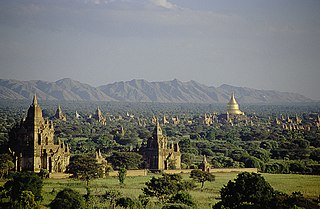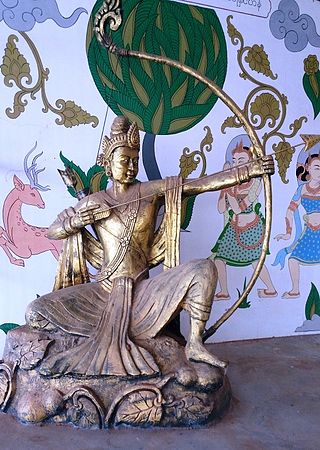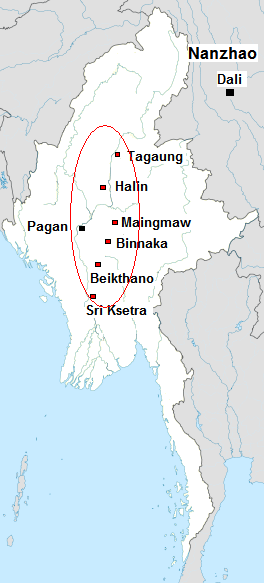
Anawrahta Minsaw was the founder of the Pagan Empire. Considered the father of the Burmese nation, Anawrahta turned a small principality in the dry zone of Upper Burma into the first Burmese Empire that formed the basis of modern-day Burma (Myanmar). Historically verifiable Burmese history begins with his accession to the Pagan throne in 1044.
Theinhko was king of the Pagan dynasty of Burma (Myanmar) from c. 934 to c. 956. According to the Burmese chronicles, Theinhko was a son of the previous king, Sale Ngahkwe. Theinhko was killed by a farmer, Nyaung-u Sawrahan, from whose farm he took a cucumber. The king had been on a hunting trip and separated from his retinue, exhausted and thirsty. The farmer was accepted as king by the queen to prevent unrest in the kingdom and became known as the "Cucumber King", "farmer king" or "Taungthugyi Min".
Nyaung-u Sawrahan was king of the Pagan dynasty of Burma (Myanmar) from c. 956 to 1001. Although he is remembered as the Cucumber King in the Burmese chronicles based on a legend, Sawrahan is the earliest king of Pagan whose existence has been verified by inscriptional evidence. According to scholarship, it was during Sawrahan reign that Pagan, then one of several competing city-states in Upper Burma, "grew in authority and grandeur". The creation of Burmese alphabet as well as the fortification of Pagan may have begun in his reign.
Saw Lu was king of Pagan dynasty of Burma (Myanmar) from 1077 to 1084. He inherited from his father Anawrahta the Pagan Empire, the first ever unified kingdom of Burma (Myanmar) but proved an inexperienced ruler. In 1082, he faced a rebellion in Lower Burma, and was captured c. April 1083. He was later killed in captivity about a year later.

Arimardanna Pura is the most famous classical name of the city of Bagan (Pagan), Myanmar. It means the "City that Tramples on Enemies."
Narapati Sithu was king of Pagan dynasty of Burma (Myanmar) from 1174 to 1211. He is considered the last important king of Pagan. His peaceful and prosperous reign gave rise to Burmese culture which finally emerged from the shadows of Mon and Pyu cultures. The Burman leadership of the kingdom was now unquestioned. The Pagan Empire reached its peak during his reign, and would decline gradually after his death.

Kyansittha was king of the Pagan dynasty of Burma (Myanmar) from 1084 to 1112/13, and is considered one of the greatest Burmese monarchs. He continued the social, economic and cultural reforms begun by his father, King Anawrahta. Pagan became an internationally recognized power during his 28-year reign. The Burmese language and culture continued to gain ground.
Sokkate was king of Pagan dynasty of Burma (Myanmar) from 1038 to 1044. The king lost his life in a single combat with Anawrahta, who succeeded him and went on to found the Pagan Empire.

Kyiso was a king of the Pagan dynasty from 1021 to 1038. According to the Burmese chronicles, Kyiso was a son of King Nyaung-u Sawrahan but raised by King Kunhsaw Kyaunghpyu. Kunhsaw married Nyuang-u's three chief queens, two of whom were pregnant and subsequently gave birth to Kyiso and Sokkate. Sokkate and Kyiso were raised by Kunhsaw as his own sons. When the two sons reached manhood, they forced Kunhsaw to abdicate the throne and become a monk.

Kunhsaw Kyaunghpyu was king of the Pagan Dynasty of Burma (Myanmar) from 1001 to 1021. He was the father of Anawrahta, the founder of Pagan Empire. The principality of Pagan continued to gain strength during his reign. Pagan's surviving walls were most likely constructed during his reign.
Sale Ngahkwe was king of Pagan dynasty of Burma (Myanmar) from c. 904 to c. 934. According to the Burmese chronicles, Ngahkwe, a descendant of King Thingayaza of Pagan but brought up in obscurity at Sale in central Burma, came to work in the service of King Tannet as a stable groom. Ngahkwe then assassinated the king and seized the throne.
Tannet was king of Pagan dynasty of Burma (Myanmar) from c. 876 to c. 904. A son of King Pyinbya, the founder of Pagan (Bagan), Tannet was the paternal grandfather of King Anawrahta, the founder of Pagan Empire. The king loved horses and was a master of horsemanship. He was assassinated by Sale Ngahkwe, his stable groom, who succeeded him as king.

The Sagaing Kingdom was a small kingdom ruled by a junior branch of the Myinsaing dynasty from 1315 to 1365. Originally the northern province of Sagaing of the Pinya Kingdom, it became de facto independent after Prince Saw Yun successfully fought for autonomy from his father King Thihathu in 1315–17. Sagaing formally seceded from Pinya in 1325 after Thihathu's death.

Pyusawhti was a legendary king of Pagan Dynasty of Burma (Myanmar), who according to the Burmese chronicles supposedly reigned from 167 to 242 CE. The chronicles down to the 18th century had reported that Pyusawhti, a descendant of a solar spirit and a dragon princess, was the founder of Pagan—hence, Burmese monarchy. However Hmannan Yazawin, the Royal Chronicle of Konbaung Dynasty proclaimed in 1832 that he was actually a scion of Tagaung Kingdom and traced his lineage all the way to Maha Sammata, the first king of the world in Buddhist mythology.

Hmannan Maha Yazawindawgyi is the first official chronicle of Konbaung Dynasty of Burma (Myanmar). It was compiled by the Royal Historical Commission between 1829 and 1832. The compilation was based on several existing chronicles and local histories, and the inscriptions collected on the orders of King Bodawpaya, as well as several types of poetry describing epics of kings. Although the compilers disputed some of the earlier accounts, they by and large retained the accounts given Maha Yazawin, the standard chronicle of Toungoo Dynasty.

Zatadawbon Yazawin is the earliest extant chronicle of Burma. The chronicle mainly covers the regnal dates of kings as well as horoscopes of select kings from Pagan to Konbaung periods. In terms of regnal years, the chronicle is considered "the most accurate of all Burmese chronicles, particularly with regard to the best-known Pagan and Ava kings, many of whose dates have been corroborated by epigraphy."

The Early Pagan Kingdom was a city-state that existed in the first millennium CE before the emergence of the Pagan Empire in the mid 11th century. The Burmese chronicles state that the "kingdom" was founded in the second century CE. The seat of power of the small kingdom was first located at Arimaddana, Thiri Pyissaya, and Tampawaddy until 849 CE when it was moved to Pagan (Bagan).

Thiri Pyissaya is a classical name of the city of Bagan, Myanmar. According to the Hmannan Yazawin chronicle, King Thinli Kyaung I moved the palace to Thiri Pyissaya, not far from the original site at Arimaddana. It ceased being the site of the palace when King Thaik Taing moved the palace to Tampawaddy, near Thiri Pyissaya.

The Sawlumin inscription is one of the oldest surviving stone inscriptions in Myanmar. The slabs were mainly inscribed in Burmese, Pyu, Mon and Pali, and a few lines in Sanskrit. According to an early analysis, the stele was founded in 1079 by King Saw Lu of Pagan (Bagan).











